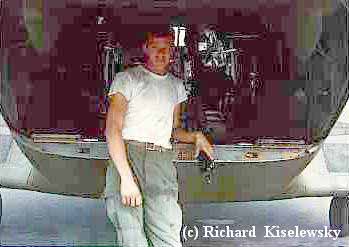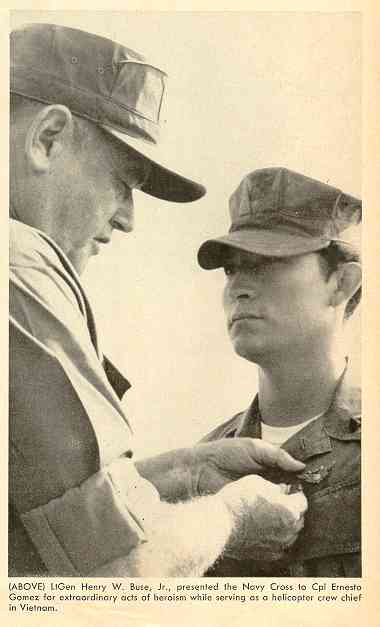 well.
When the smoke was deployed, and Army CH-54 moved in and YK-5 went home
for repairs.
well.
When the smoke was deployed, and Army CH-54 moved in and YK-5 went home
for repairs.
YK-5 DOWN IN THE "ARIZONA TERRITORY"
On the morning of February 26th, 1969 YK-5, with LtCol. E. R. Brady, CO of HMM-364 as the pilot, 1stLt. Gary Stackhouse as the copilot and Cpl. Ernesto "Gooie" Gomez as crew chief, was directed by Na Nang Direct Air Support Center (DASC) to conduct a medical evacuation (medevac). The medevac was located in the area south west of Da Nang known as the Arizona Territory. The Arizona Territory continued to be a highly contested and very unfriendly area for all helicopter aircrews. It was flat, low lying, terrain which was defined as a triangular piece of real estate lying south of the Song Vu Gia river and north of the Song Thu Bon river. The Song Vu Gia flowed into the Song Thu Bon and formed the eastern end of the Arizona Territory. If possible, most pilots would avoid overflying the Arizona Territory unless their mission specifically required them to do so.
The medevacs were Marines whose unit had been under Viet Cong (VC and/or Charlie) attack throughout the previous night. The crew of YK-5 had received the zone briefing from the UH-1 (HUEY) gun ships of HML-167. YK-5 received VC small arms fire during the approach to the zone. Cpl. Gomez successfully loaded seven medevacs, and called "ramp up" to LtCol. Brady indicating he was cleared to depart the zone. YK-5, with her gunners delivering 50 caliber suppressive fire toward the enemy positions in the treeline along the river, had been airborne less than thirty seconds when VC fire seriously damaged flight control and other systems of the helicopter. The cockpit was saturated with hot forward transmission oil and red hydraulic fluid. The smell of JP (jet) fuel was apparent throughout the cockpit and cabin area. LtCol. Brady struggled to turn the helicopter around and was attempting to return to the original LZ where "friendly" forces could provide them some measure of security. Damage to YK-5 did not allow this, the flight control systems were gone and the helicopter came down in a rice paddy approximately 350 to 400 meters from those Marines. LtCol. Brady relates, "It must be added that Gooie Gomez, our plane captain was our third pilot as we 'crash landed'. His hands were all over the cockpit, helping to shut down all systems, reducing the threat of fire."
The crew immediately set up a defensive perimeter behind the rice paddy berms around YK-5 utilizing their personal weapons consisting of 38 caliber revolvers for the pilots, personal side arms of the other crewmen augmented with M-16 rifles, and the 50 caliber machine guns which remained in their mounts aboard YK-5. Though wounded, the medevacs also joined in developing this defensive perimeter.
Concurrently, Maj. O. C. Baker and Capt. Richard Bianchino in another "Purple Fox" aircraft were conducting a resupply mission for the Republic of Korea (ROK) Marines a few miles to the north east when they head Da Nang DASC report that a Swift (tactical call sign for HMM-364) Medevac was down in the Arizona Territory and provided the grid coordinate location. Capt. Bianchino was flying his first mission with the "Purple Foxes" but was a seasoned combat veteran who had served a previous tour in Vietnam as an infantry officer in units working in and around the Arizona Territory. Capt. Bianchino identified the location of the crash site on his map while Maj. Baker requested clearance from Da Nang DASC to assist YK-5.
Some time passed before the extraction could be accomplished. During this time one of the wounded marines, for reasons unknown, decided he was going to traverse the hostile area and return to the position he had been removed from. He proceeded from the site of YK-5 approximately 35 meters and collapsed. LtCol. Brady immediately, and without regard for his safety, left the relative security of the defensive position, crossed the 35 meters under fire, lifted the wounded Marine onto his back and retraced his steps to the YK-5 position.
LtCol. Brady, utilizing the hand held radio in his survival jacket maintained UHF radio communications with aircraft in the area advising them of the direction and distance from their position they were receiving fire. LtCol. Brady had assumed the duties of a forward air controller (FAC) thus provided for effective fire support missions in defense of those at the crash site.
A flight of 6 or 8 Army HUEY gun ships, call sign "Black Cat", were en route to Marble Mountain after completing their assigned mission. They had heard of YK-5's situation, checked in with LtCol. Brady using the call sign (Swift-6 or Swift Medevac) and offered their assistance. They had not expended all of their ammunition and had some fuel remaining. LtCol. Brady, acting as the FAC, utilized these assets to thwart the forward movement of "Charlie" who was intent on reaching the crash site. As the Black Cat flight were getting low on ammunition they continued to make runs on the VC positions but would only fire very few rounds at a time. Finally they were out of ammunition, but made a couple additional "dry" runs simply to hold "Charley" in position. They could not continue this tactic for long and finally the flight leader told LtCol. Brady they were out of ammunition, low on fuel and had to "bingo" back to Marble Mountain with the final transmission of, "Good luck Swift MEDEVAC."
Marines from the original medevac zone formed a platoon to move to the crash site for additional security. They were hampered by additional VC forces in their path. Eventually they closed on the crash site and related they had encountered and killed two or three VC's who had moved to positions a few meters outside the YK-5 site. The site now had an additional twelve or thirteen Marines to provide security.
An OV-10 of VMO-2, piloted by Bert Nail, checked in with LtCol. Brady and commenced suppressive fire support. It was determined the time was now right for Major Baker and Capt. Bianchino to conduct the rescue of YK-5's crew and medevacs. The OV-10 and two HUEYs form HML-167 escorted Maj. Baker and crew into the hot LZ. Upon landing the wounded Marines were being assisted into Maj. Baker's helicopter. LtCol. Brady was assisting one Marine when the young Marine was hit again. Now this dead Marine had to be carried on board Maj. Baker's aircraft.
The following is a narrative provided by Richard L. Bianchino, LtCol. USMC (Ret):
"As we waited in the zone for all the stranded Marines to board, Maj. Baker and I saw mortar rounds "walking" from the west toward us. I saw LtCol Brady coming toward the aircraft with a Marine on his shoulder. They were the last to get aboard. With everyone accounted for, Maj. Baker executed a maximum performance, climbing right turn departure from the crash site. As we climbed out I saw the OV-10, inverted, coming over the top. As he rolled wings level, he fired rockets. We were right in front of him, he was coming toward us from our right. As we continued our turn to the right the rockets passed just in front of the aircraft looking like big silver streaks. We flew through the rocket's exhaust trail. The OV-10 broke to his left and passed just behind us and through our rotor wash. That was close! As we continued our right turning climb to a safe altitude, LtCol. Brady crawled into the cockpit and gave us a "thumbs up." The remainder of the flight was uneventful."
While en route to Marble Mountain, Cpl. Gomez remembers hearing LtCol. Brady say, "I could hear the bullets hit his body", referring to the Marine he was assisting to the extract helicopter.
Two days later, with the aid of an Army CH-54 Crane, Cpl. Gomez returned to the crash site as a member of 1stLt. Courtney Payne's team to recover YK-5.
Thirty one years later the above narrative prompted the following additional information about the incident described above.
Richard Kiselewsky, who was the squadron's armor and permanent member of the aircraft recovery crew, sent the following email to Gene Brady.
Dear Col. Brady,
So you're the guy that put that aircraft there. I was on the recover team (and yep--Gooie was there also with his M-14 on full auto :-) ) when Lt. Courtney Payne took us (yet again) to see the beauty of Vietnam from the ground level. On the first attempt we were unable to recover the aircraft due to heavy enemy contact on the ground. As night closed in it was decided that the recovery team would be extracted for the night since the grunts, who were already there, would continue to provide aircraft security.
I recall setting up a .50 Cal in the downed aircraft, as additional fire power for the grunt security element, and making sure it functioned as advertised (I still recall it was one of the few guns we had manufactured by Singer Sewing Machine Company) and were extremely reliable as was proven out by their use during our time away. I still recall a grunt Lt. commenting in a positive way about it's effect on a gook sniper that was bothering them all night. Ahhhhhh--gotta love those .50s :-)
The next day we went in again
and this time the Navy showed up with some A-4s ( I recall you flew them)
with smoke canisters slung under the wing pylons for the purpose of placing
a smoke screen between the enemy and the Army CH-54 which was to lift YK-5
out. One thing went wrong. The Navy pilots screwed up and failed
to eject the smoke canisters. After a trip back to the carrier and
some additional local instruction they returned and all went  well.
When the smoke was deployed, and Army CH-54 moved in and YK-5 went home
for repairs.
well.
When the smoke was deployed, and Army CH-54 moved in and YK-5 went home
for repairs.
Sooooooooooo ---Thank you kind sir for yet another fun filled day in Vietnam!! :-)
Respectfully,
Rich
Kiselewsky
Additional Short But Vivid Memories of Gary Stackhouse
 Gene
Brady recalls, "In a twist of fate, Rich Bianchino was one of
the pilots who rescued us only to be shot down with Gooie on Charlie Ridge
in the same plane (YK-5). I flew as copilot on the rescue mission.
Earnie Cunningham was the HAC on this mission and did a superb job. Thankfully
Gooie and Rich survived. Many did not. There were many heroics.[Details
of the Charlie Ridge story on 4/14/69]. And Gooie
got a new YK-5. We called it the Phoenix Bird."
Gene
Brady recalls, "In a twist of fate, Rich Bianchino was one of
the pilots who rescued us only to be shot down with Gooie on Charlie Ridge
in the same plane (YK-5). I flew as copilot on the rescue mission.
Earnie Cunningham was the HAC on this mission and did a superb job. Thankfully
Gooie and Rich survived. Many did not. There were many heroics.[Details
of the Charlie Ridge story on 4/14/69]. And Gooie
got a new YK-5. We called it the Phoenix Bird."
Information provided by:
Eugene
"Gene" Brady, Col. USMC (Ret)
Owen
C. Baker, Col USMC (Ret)
Ernesto
"Gooie" Gomez, Cpl USMC
Richard
L. Bianchino, LtCol USMC (Ret)
Gary
E. Stackhouse, 1stLt. USMCR
Richard Kiselewsky,
Sgt. USMC
Last Updated: September 3, 2000
Back Browser or Home
x